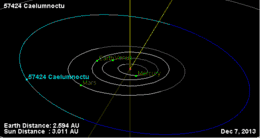57424 Caelumnoctu
 Orbital diagram of Caelumnoctu | |
| Discovery [1][2] | |
|---|---|
| Discovered by | LINEAR |
| Discovery site | Lincoln Lab's ETS |
| Discovery date | 16 September 2001 |
| Designations | |
| MPC designation | (57424) Caelumnoctu |
Named after |
The Sky at Night [2] (BBC astronomy programme) |
| 2001 SP22 · 1982 BV4 | |
|
main-belt · (outer) Eos [3] | |
| Orbital characteristics [1] | |
| Epoch 4 September 2017 (JD 2458000.5) | |
| Uncertainty parameter 0 | |
| Observation arc | 35.76 yr (13,061 days) |
| Aphelion | 3.3243 AU |
| Perihelion | 2.7495 AU |
| 3.0369 AU | |
| Eccentricity | 0.0946 |
| 5.29 yr (1,933 days) | |
| 334.96° | |
| 0° 11m 10.32s / day | |
| Inclination | 9.6708° |
| 353.32° | |
| 45.951° | |
| Physical characteristics | |
| Dimensions | 6.876±0.356 km[4] |
| 0.113±0.019[4] | |
| 13.7[1] | |
|
| |
57424 Caelumnoctu, provisional designation 2001 SP22, is an Eoan asteroid from the outer regions of the asteroid belt, approximately 7 kilometers in diameter. It was discovered on 16 September 2001, by astronomers of the Lincoln Near-Earth Asteroid Research at Lincoln Laboratory's Experimental Test Site near Socorro, New Mexico. The asteroid was named for the BBC television programme The Sky at Night.[2]
Orbit and classification
Caelumnoctu is a member the Eos family (606),[3] the largest asteroid family in the outer main belt consisting of nearly 10,000 asteroids.[5]:23
It orbits the Sun at a distance of 2.7–3.3 AU once every 5 years and 3 months (1,933 days; semi-major axis of 3.04 AU). Its orbit has an eccentricity of 0.09 and an inclination of 10° with respect to the ecliptic.[1]
The body's observation arc begins with its first identification as 1982 BV4 at Kiso Observatory in January 1982, more than 19 years prior to its official discovery observation at Socorro.[2]
Physical characteristics
The body's spectral type is unknown.[1] Its albedo, however, corresponds to the K-type asteroids of which the Eos family predominantly consists.[5]:23
Diameter and albedo
According to the survey carried out by the NEOWISE mission of NASA's Wide-field Infrared Survey Explorer, Caelumnoctu measures 6.876 kilometers in diameter and its surface has an albedo of 0.113.[4]
Rotation period
As of 2017, no rotational lightcurve of Caelumnoctu has been obtained from photometric observations. The body's rotation period, poles and shape remain unknown.[1][6]
Naming
This minor planet was named "Caelumnoctu" (Latin for The Sky at Night) in honour of the BBC television programme which celebrated its 50th anniversary in 2007. The number "57424" refers to the date of the first broadcast, 24 April 1957.[2]
The official naming citation was published by the Minor Planet Center on 2 April 2007 (M.P.C. 59387).[7]
References
- 1 2 3 4 5 6 "JPL Small-Body Database Browser: 57424 Caelumnoctu (2001 SP22)" (2017-10-30 last obs.). Jet Propulsion Laboratory. Retrieved 23 November 2017.
- 1 2 3 4 5 "57424 Caelumnoctu (2001 SP22)". Minor Planet Center. Retrieved 23 November 2017.
- 1 2 "Small Bodies Data Ferret". Nesvorny HCM Asteroid Families V3.0. Retrieved 23 November 2017.
- 1 2 3 Masiero, Joseph R.; Mainzer, A. K.; Grav, T.; Bauer, J. M.; Cutri, R. M.; Dailey, J.; et al. (November 2011). "Main Belt Asteroids with WISE/NEOWISE. I. Preliminary Albedos and Diameters". The Astrophysical Journal. 741 (2): 20. arXiv:1109.4096. Bibcode:2011ApJ...741...68M. doi:10.1088/0004-637X/741/2/68. Retrieved 23 November 2017.
- 1 2 Nesvorný, D.; Broz, M.; Carruba, V. (December 2014). "Identification and Dynamical Properties of Asteroid Families" (PDF). Asteroids IV: 297–321. arXiv:1502.01628. Bibcode:2015aste.book..297N. doi:10.2458/azu_uapress_9780816532131-ch016. Retrieved 23 November 2017.
- ↑ "LCDB Data for (57424) Caelumnoctu (not in the LCDB)". Asteroid Lightcurve Database (LCDB). Retrieved 23 November 2017.
- ↑ "MPC/MPO/MPS Archive". Minor Planet Center. Retrieved 23 November 2017.
External links
- Asteroid Lightcurve Database (LCDB), query form (info)
- Dictionary of Minor Planet Names, Google books
- Asteroids and comets rotation curves, CdR – Observatoire de Genève, Raoul Behrend
- Discovery Circumstances: Numbered Minor Planets (55001)-(60000) – Minor Planet Center
- 57424 Caelumnoctu at the JPL Small-Body Database